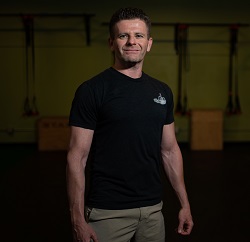This post was written in Janauary… AKA, the ‘New year’s resolution/start a crazy unsustainable workout plan’ time of year. If you’re over the age of 40 and you’re seeing all the ads and offers out there, you may be thinking to yourself, “I’m sure these insane workouts could work for the young crowd, but what about me?”
Well… I’m here to help you out!
First and foremost, if you’re reading this, I’m assuming you’re already sold on the importance of strength training. But in case you haven’t gotten the memo: If tomorrow a pill came out promising increased strength, decreased body fat, lowered blood pressure, improved mental health, significantly lowered all-cause mortality etc. etc., there would be a line wrapped around the pharmacy to buy it.
However, this “pill” already exists… it’s called, “A consistent, well-executed strength training program.”
In today’s post, I’d like to outline the basic things someone over 40 (or over 50, or even over 60 for that matter) should be concerned about when starting a strength training program. Let’s get started…
Step 1: Start Slow
We live in a culture of ‘working out’ not ‘training’. Think about what the word ‘workout’ conjures up? “He ‘worked’ himself ‘out’.” Our fitness culture makes us think that if we don’t reduce ourselves to a pile of jello by the end of each session, we somehow didn’t do it right.
“That workout was pointless! I didn’t even throw up in the parking lot afterwards!”
This is one of the biggest mistakes older athletes make. This training methodology simply doesn’t stand the test of time. Start slow, and build it up.
Step 2: Focus on “The Big Motors”
What are “the big motors” you ask?
- Vertical/horizontal press
- Vertical/horizontal pull
- Squat
- Deadlift
- Loaded carries
Until one becomes strong in these big motor movements, all the exercises for smaller muscle groups can wait. In other words, if you cannot squat properly or carry your own bodyweight for 60 seconds, the bicep curls can wait.
—
We use and recommend Legion supplements! Please support our blog by shopping the link below and use coupon code PROTOCOLSC to save 20% off your purchase!

“There are a lot of sleazy supplement companies out there, but Legion is not one of them. Their products are free of fillers and inactive ingredients and they take the time (and money) to test them with independent labs to ensure you’re getting what you pay for.” Dr. Spencer Nadolsky, MD
—
Step 3: Don’t Ignore Zone 2
If you’ve been reading my stuff for the past few years, you know I’ve been shouting the virtues of zone 2 cardio from the rooftops to anyone willing to listen.
What is zone 2?
Zone 2 is essentially a steady-state training session that is at a low enough intensity to where it is comfortable and maintainable for 45 to 90 minutes. Heart rate is generally 60% to 70% of your max heart rate, but if you’re like me, you’re not into all those tracking gadgets, so keeping the ability to maintain conversation does the job quite nicely. Light rowing, hikes, bike rides, jogs, etc. etc.
About two years ago, I started doing these sessions 5-6 days per week. I didn’t notice the benefits instantly, but within about a year, the changes in my body (and mind) were quite evident.
The nice thing about Zone 2 is that just about anyone, regardless of their fitness capacity, can start doing this right away… no fancy gym required, and no costs incurred. Just like step one, start with shorter sessions and build up.
Don’t have time? I’ll quote one of my mentors, “If you don’t have time for an hour of movement per day, it means you need two.”
—
Please help support our blog by shopping Amazon using the link below…
—
Step 4: Don’t Train To Failure
I grew up in the fitness culture of “Bro-Science.” This was fitness advice that one bro has handed down to another bro for decades. Some advice was good… most was not. One of the greatest fallacies that was uttered over and over again was that you should always train to failure (AKA do the exercise to complete muscular exhaustion).
“C’mon BRO! One more rep BRO! You got this Bro!”
As I got older (and became a wiser bro), I began to discover that, as you study the training habits of the world’s strongest humans, none of them train like this. Dr. Fred Hatfield AKA “Dr. Squat” squatted 1,014 pounds at the tender young age of 45. His famous quote, “I don’t train to failure… I train to success.”
Most of the magic of strength training happens in the 60%-90% of one-rep max range (and 90% is done sparingly). Not only is this very sustainable long-term, but it is also much safer than constantly pushing one’s limits. Remember, an injury is lost training time, and the older you are, the longer it takes to recover from an injury. Life is not fair.
—–
If you need help designing a program, our would just like to discuss your training goals, please schedule a free 45-minute coaching call by CLICKING HERE.
Until next time,
Jerry Trubman is a coach, clinician, author, blogger, and powerlifting state champion. With over two decades of lifting experience, he has devoted himself to seeking out better answers, and distilling them into practical programs that produce great results. Jerry has coached “Team Protocol” to 4 National Powerlifting Championships in the 100% Raw federation. He writes the internationally-read blog, “The Healthy Addiction” and lives in Tucson, Arizona with his wife, Marie, and dog, Asher.



